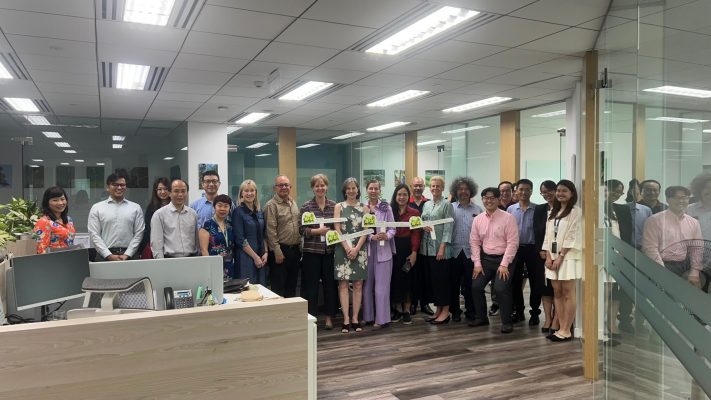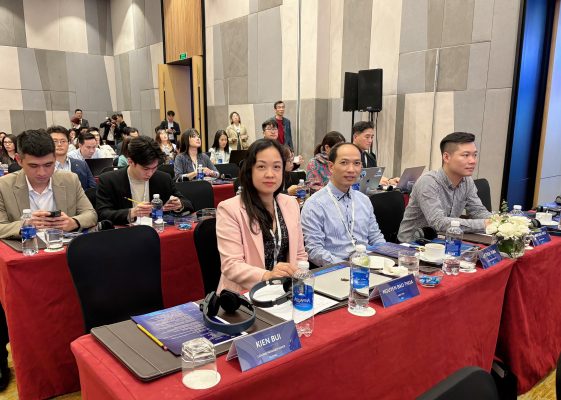Bronze casting, flourishing in the imperial city of Hue
On their first visit to the imperial city of Hue, visitors are often surprised at seeing huge ancient bronze casting items. They include the cauldron in the front yard of Can Chanh Palace, a set of nine urns at Hien Lam Palace, the arc girders on Trung Dao bridge that links Thai Hoa Palace’s yard to Ngo Mon Gate, the nine statues of Genies standing inside Quang Duc and The Nhan gates, the half-length portrait of the patriotic Phan Boi Chau located on the top of Ben Ngu hill, just to name a few. Except for the bust of Phan Boi Chau all other tems were cast from the early 18th to the early 19th centuries.
Those who understand the history of Vietnamese handicrafts wonder how the local craftsmen in the old time, with rudimentary techniques, could cast such huge items in bronze weighing thousands of kilograms, and how those items could withstand the harsh weather over several centuries, without showing any cracks.
Meanwhile, others who specialize in fine arts pay more attention to the designs of leaves, flowers, birds, ani- and round points engraved on the cauldrons or bas-relieves on the nine urns. The designs remind them of similar ones on the ancient bronze pots as well as the similarity between Vietnamese and Western fine arts. They are similar to designs of climb flowers and other stylized flowers and fruits on the bronze guns made in Holland and Portugal, which are now preserved at Hue Antiques Museum. It can be said that the 162 bas-relieves carved on the nine urns; are consid- the first showpieces describing the beautiful land of Vietnam in the early 19th century.
Experts on sound research have said that its’ difficult to cast caul-drons, guns and urns with engraved bas-relieves, but it’s more difficult to make these items produce nice sounds. At night, amid the tranquil atmosphere, listening to the bell ring- from Thien Mu Tower, everyone is impressed and admires the talent of the bronze casting artisans of Hue, who produced such wonderful works. Their handicraft expertise has raised a lot of discussion and study from the French time (1882-1945) to the year of 1975 (when southern Vietnam was completely liberated). Since Hue was recognized as a World Cultural Heritage Site in 1993, the Toyota Foundation of Japan and UNESCO have paid great attention to the bronze casting in Hue
After building his headquarters in Kim Long in 1635, Lord Nguyen Phuc Lan (or Lord Thuong) ordered the establishment of barracks on the southern bank of the Huong (Perfume) River, opposite to his headquarters, to cast weapons and royal utensils, such as lamps, incense joss stick holders, bells, statues, urns and plaques. Later, the craft of bronze casting was handed down to the children of the craftsmen, who built up villages and worked togeth- until the present day. The most reputed villages are Giang Dinh, Giang Tien, Kinh Nhon Ban Bo and Truong Dong- The villagers of Kinh Nhon are members of the Nguyen family and are natives of Bao Ninh Province in northern Vietnam, and the Tong family (of Thanh Hoa Province in Central Vietnam). Members of their 10th generation arestill practicing bronze casting in Hue. some bronze casting craftsmen from northern Vietnam went to settle in Phuoc Kieu village in Dien Ban District, Quang Nam Province (southern Vietnam), and later they moved to Hue and have practiced bronze casting since the time of Canh Thinh (1792-1801).
However, studies show that when casting huge items, skillful artisans from nationwide were asked to work together with Hue workers. For instance, to cast guns, skilled workers from Phan Xa and Hoang Giang (Khang Loc District, Quang Binh Province in Central Vietnam) were called to Hue to work.
To improve the Vietnamese workers’ skill, Lord Hien Vuong (1648- invited Joao da Crus, a Portugese-Indian engineer, to come and teach the techniques of metal processing and artillery casting.
In return, Hien Vuong built a chapel, later becoming a temple, dedicated to bronze casting craftsmen, which has been kept intact until now.
Maybe because of the application of advanced techniques from the West, the bronze casting in Hue is superior than those in other localities.
Fuel and raw materials, play an important role in bronze casting. Fuel can be made from the timber of Van Nien forest, but raw materials, copper and tin in particular, were very rare in Vietnam at that time. To have enough materials for the casting of weapons and royal utensils, the Nguyen lords had to place orders with the merchant ships from Fujian, Guang-zhou (China) and Japan. One of the Nguyen lords even permitted a daughter, Amo, to marry a Japanese trader, Araki Sotaro, who helped him and other Nguyen lords buy copper and tin and other materials for cast- guns. Thanks to this advantage, the Nguyen lords defeated the Trinh troops in the north and Chiem and Chan Lap troops in the south.
In the French colonial time, the Nguyen kings no longer controlled the bronze casting groups, and the craftsmen enjoyed free production and trading. They used to cast civil utensils such as pots, pans, lime pots, areca nut boxes, and fine arts articles for decoration. During the French resistance war, they cast and repaired weapons and -silver coins. Prior to 1975, upon the requirement of the patriotic movement in Hue, the local casting workers were ordered to cast a statue of Phan Boi Chau’s halflength portrait, the ever biggest bust in Vietnam, which is 4 metres high and 11 metres in diameter.
Since the country was reunified in 1975, the casting workers in Hue have used the waste materials of war to cast consumer items, which are widely sold in the central region. Together with development of local tourism, fine arts articles made of bronze, such as incense joss stick holders, urns, statues, bas-relieves and artificial antique coins have been produced en mass. At present there are about 50 bronze casting kilns operating, compared to only 2 kilns prior to 1975.
Recently, members of the Nguyen Kinh Nhon family successfully pro- a sample of a Dong Son drum (an artifact from Dong Son time n the 3rd century), which won high praise from the cultural authorities. The burial ground and the shrine of the Nguyen Kinh Nhon family has been recognized as a national histori- and cultural site by the State.
Bronze casting, through the deli expertise of the local workers, plays an important role in Hue’s material and non-material heritage and at the same time is a world cultural treasure.
Thai Binh Province is not only acknowledged as a rice field in the North, but also as home to traditional craft villages. Dong Xam Silver Village is one of the most famous ones…
Dong Xam Silver Village is located in Hong Thai Commune, the north of Kien Xuong District, Thai Binh Province. Dong Xam is a village whose population is skilled in metal carving. The craft of silver processing in Dong Xam Village has existed since the 17th Century.
As of March 2003, the village has been acknowledged as qualified craft village and has a wide range of consumer’s favorite handicrafts. Dong Xam Silver Village is known not only in the Vietnam, but also overseas. The handicrafts are produced for both domestic use and export to foreign markets, including Japan, South Korea, Taiwan, Laos, Thailand, Netherlands, and Spain.
Silver has been used for many centuries, going back to ancient times. Periodically, it enjoys great popularity as it does currently. Silver is the most common of the precious metals. It is working qualities are very similar to gold. In fact, silver shines above all other metals in this respect. Silver carving products of Dong Xam village is so different from the ones of other places. Dong Xam’s products are characterized by strange styles of cube and appearance, by sophisticated and well-proportioned decorations, by delicate and perfect skill. It can be said that the skill and carefulness of Dong Xam artists have been able to satisfy all the demands for using silver carving products of customers who are difficult and knowledgeable about silver carving art. Dong Xam artists always think high of “faithfulness” and “talent”. Therefore, their products, which are always genuine and carefully-made, keep maintaining customers’ confidence.
According to the local people, 300 hundred years ago, there was an artist named Nguyen Kim Lau, who travelled downstream on the Tra Ly River by boat to Dong Xam to make a living. He transferred his silver carving skills to the local people. Over time, silver carving has been maintained and developed. After his death, the Dong Xam Temple was built in appreciation of his contributions to the village and the festival in the temple is yearly held to mark the anniversary of the progenitor Kim Lau’s death.
Dong Xam Temple Festival annually takes place from the 1st to the 3rd day of the fourth lunar month and attracts many tourist from everywhere. The most exciting program is the boat racing contest on river with the participation of youth men in the hamlet and neighboring communes. Besides, there remains interesting traditional games and folk cultures like ca tru and cheo singing.
In the days of Dong Xam Temple Festival, a great deal of beautiful silver carving products are displayed and sold as souvenir for tourists.





